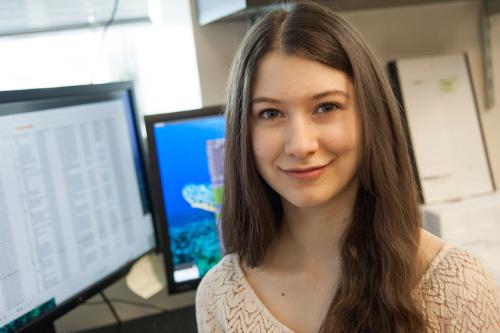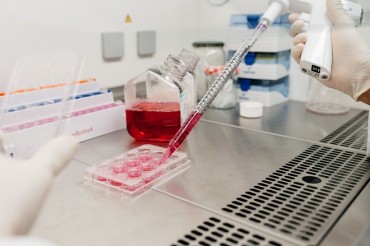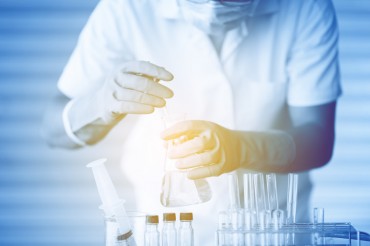
Teenage cancer survivor Elana Simon, 18, in her father’s Rockefeller University lab, where she worked to uncover an unusual mutation that is strongly linked to her own rare disease, fibrolamellar hepatocellular carcinoma. (Photo: PRNewsFoto/Rockefeller University)
NEW YORK, Feb. 28, 2014 (Korea Bizwire) – A father-daughter scientific collaboration that began after the daughter was diagnosed with a rare liver cancer has led to an important finding and could have broader implications for many other rare cancers. Their story is being published this week in a top tier journal, Science.
Elana Simon, the daughter of Rockefeller University professor Sanford Simon, received a devastating cancer diagnosis at age 12 — a rare and often deadly type of liver cancer called fibrolamellar hepatocellular carcinoma. Like many rare adolescent cancers, it is not well understood because research funding typically goes to more common cancers. But four years after her surgery, in which most of her liver was removed, she began interning in a biology lab, and came up with a new idea for understanding the genetics behind her own tumor.
“I reasoned that it would be easier to identify genetic mutations in the tumors of young patients than it is in older ones, because in older people, their genomes have been altered by years of aging and environmental factors,” says Elana Simon, an 18-year-old senior at the Dalton School who will attend Harvard this fall. “Also, in an adolescent, a tumor has not been around for very long, so the tumor itself will have less time to accumulate mutations. When we identify a possible mutation in an adolescent, it is much more likely that it’s driving the cancer.”
Elana also wanted to sequence the entire genome, 3 billion base pairs long, rather than just the shorter exome, which is the more manageable section that is often tackled. But the teen’s comfort with computer science and her drive to unlock the mystery of her own cancer compelled her to take on the challenge.
Meanwhile, to obtain as large a collection of tissue as possible, Elana reached out to other patients asking them to contribute their tissues, extracted during surgery, to a repository set up at Rockefeller. Together with other patients and their family members she started a website to serve as repository for what little knowledge there was about fibrolamellar cancer. Though they lacked federal funding, the father-daughter team sought and received support in the form of private gifts from the Fibrolamellar Cancer Foundation and several individual donors whose lives have been touched by the disease, in addition to support from the Howard Hughes Medical Institute, the New York Genome Center, The Rockefeller University Center for Clinical and Translational Science and through a gift to The Rockefeller University by an anonymous donor.
Elana worked in her father’s lab after school and during breaks. In a collaboration involving the Simon Laboratory at The Rockefeller University, a Memorial Sloan Kettering Center surgeon who originally treated her, Michael P. LaQuaglia, and a team of computational biologists at the New York Genome Center (NYGC), the genetic data from 15 patients’ tumors was analyzed and one abnormality was discovered that really stood out. All 15 patients had a piece of DNA that had been broken and rejoined, creating a new, mutated gene — called a chimera — that would potentially wreak havoc in the bodies of people who had it.
“We discovered chimeric RNAs in the tumor samples — made when DNA deletions create unnatural products that can drive cancer,” says Nicolas Robine, co-first author and NYGC Computational Biologist. “This chimera had never been seen before, so we believe it will help drive the work of our Rockefeller colleagues and Elana’s future. It is the NYGC’s mission to undertake such collaborative genomic studies that will accelerate medical advances.”
“If you tell a twelve year old that they have to leave school and their friends to go to the hospital and get most of their liver removed, their first question is going to be why?” says Elana. ”Being raised by a scientist my first instinct was to try to understand as much of it as my young brain could handle. However, I was disappointed to find that nobody was really able to answer my question. Fibrolamellar was a mystery to me, and, as I soon realized, a mystery to doctors and scientists as well. What was even worse was that nobody seemed to be making progress on it, as the cancer didn’t affect enough people for it to get significant attention. Someone had to do something about this disease, and since nobody else was going to, I decided to take it upon myself.”
“These results were extremely encouraging,” says Sanford Simon, head of the Laboratory of Cellular Biophysics and the study’s senior author. “It is uncommon for a genetic screen for a cancer to turn up such a strong candidate mutation, and for the mutation to be present in every single patient tested.”
The lab is now working on testing the effects of the chimera on human liver cells and in mouse livers, to further elucidate its role in the disease.
“The hope is that we’d be able to screen the blood for the presence of this chimera, and patients wouldn’t have to wait until the tumors are present, until it might be too late to do something about it,” says Sanford Simon. “Also, often with these types of discoveries, the genetic mutation turns out to be connected to other rare cancers. Many of the molecular changes we are observing are much more reminiscent of specific forms of breast cancer than liver cancer.”
“NYGC is thrilled to have this work be our first published example of the explosive power of collaborations between deeply invested biologists like those in the Simon lab including Elana Simon, and thoughtful bioinformatics scientists like Nicolas Robine and NYGC team, who worked together so effectively with the tools of genomic sequencing and analysis to discover this new chimeric protein and cancer target,” says Robert Darnell, head of Rockefeller’s Laboratory of Molecular Neuro-Oncology, HHMI Investigator, and President and Scientific Director of NYGC. “The work done serves as an exemplar for how the power of interdisciplinary and inter-institutional genomic science has the potential to save people’s lives in New York and beyond.”
“I’ve never understood why I was so lucky in my experience with cancer while so many others have it much worse than I did,” says Elana. “But I happened to get diagnosed in a time when these new sequencing technologies were really starting to flourish. I was in the perfect environment, at the right time, with the right motivation to take advantage of these technologies. All of the pieces fit together and it seemed inevitable that this was a field I was going to explore — a mystery I had to solve.”
“I want everyone out there with rare diseases to know that it’s really up to the patients to motivate progress and now we actually can do so. When I was first diagnosed with fibrolamellar, it seemed like no one cared about the disease,” Elana says. “No one knew anything about it or what to do with it. That’s what compelled me to take the science into my own hands. There are amazing advances in biomedical science being made every day. Further, new technologies are making it possible for us to share our information to help identify and understand our diseases. Through these, there is hope for cures that previously would have been considered miracles.”
About The Rockefeller University
Founded by John D. Rockefeller in 1901, The Rockefeller University was this nation’s first biomedical research institution. Hallmarks of the university include a research environment that provides scientists with the support they need to do imaginative science and a truly international graduate program that is unmatched for the freedom and resources it provides students to develop their capacities for innovative research. The Rockefeller University Hospital, founded in 1910 as the first center for clinical research in the United States, remains a place where researchers combine laboratory investigations with bedside observations to provide a scientific basis for disease detection, prevention and treatment. Since the institution’s founding, Rockefeller University has been the site of many important scientific breakthroughs. Rockefeller scientists, for example, established that DNA is the chemical basis of heredity, identified the weight-regulating hormone leptin, discovered blood groups, showed that viruses can cause cancer, founded the modern field of cell biology, worked out the structure of antibodies, devised the AIDS “cocktail” drug therapy, and developed methadone maintenance for people addicted to heroin. Throughout Rockefeller’s history, 24 scientists associated with the university have received the Nobel Prize in physiology/medicine and chemistry, and 21 scientists associated with the university have been honored with the Albert Lasker Medical Research Award. Five Rockefeller University scientists have been named MacArthur Foundation Fellows, and 20 have garnered the National Medal of Science. Currently, the university’s award-winning faculty includes five Nobel laureates, seven Lasker Award winners and three recipients of the National Medal of Science. Thirty-four of the faculty are elected members of the National Academy of Sciences. For more information, go to www.rockefeller.edu.
About the New York Genome Center
The New York Genome Center (NYGC) is an independent, nonprofit at the forefront of transforming biomedical research and clinical care with the mission of saving lives. As a consortium of renowned academic, medical and industry leaders across the globe, NYGC focuses on translating genomic research into clinical solutions for serious disease. Our member organizations and partners are united in this unprecedented collaboration of technology, science, and medicine. We harness the power of innovation and discoveries to improve people’s lives – ethically, equitably, and urgently. Member institutions include: Albert Einstein College of Medicine, American Museum of Natural History, Cold Spring Harbor Laboratory, Columbia University, Cornell University/Weill Cornell Medical College, Hospital for Special Surgery, The Jackson Laboratory, Memorial Sloan-Kettering Cancer Center, Icahn School of Medicine at Mount Sinai, New York-Presbyterian Hospital, The New York Stem Cell Foundation, New York University, North Shore-LIJ, The Rockefeller University, Roswell Park Cancer Institute and Stony Brook University. For more information, visit: www.nygenome.org.
Source: The Rockefeller University & the New York Genome Center (via PRNewswire)






